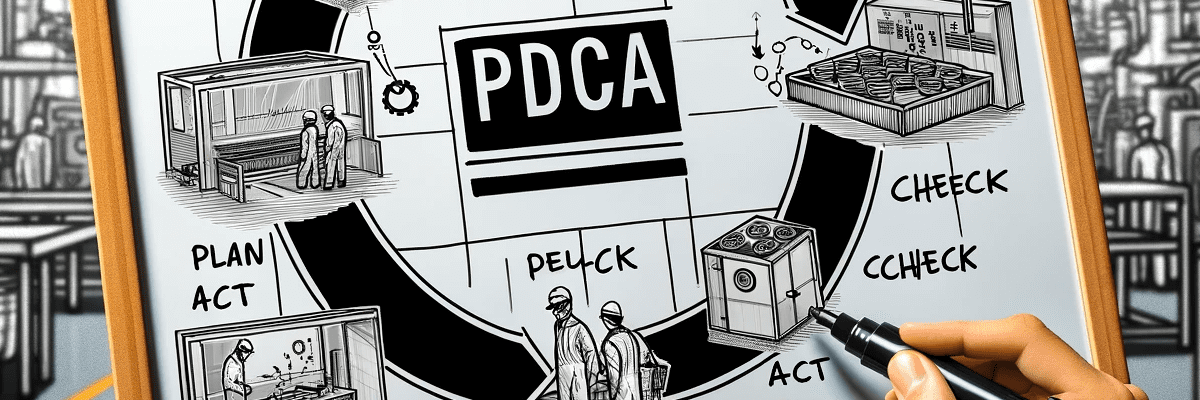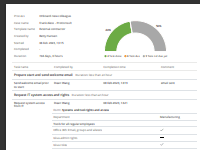
The PDCA cycle: Why and how it can help with process improvement

In the world of process improvement, there are countless methodologies and tools available to organizations looking to enhance their operations. One such method that has proven to be highly effective is the PDCA cycle. PDCA, which stands for Plan-Do-Check-Act, is a four-step continual improvement process that can help organizations identify and address areas of improvement in their processes. In this article, we will explore why the PDCA cycle is such a powerful tool and how it can be implemented to drive process improvement.
Looking for something else? Explore these related articles:
PDCA Cycle: A Proven Method for Quality Improvement
The PDCA (Plan-Do-Check-Act) cycle is a proven method for quality improvement that has been widely adopted by organizations across various industries. This structured approach provides a systematic way to address areas that require improvement, ensuring continuous progress and success.
The PDCA cycle consists of four interconnected steps that work together seamlessly to drive improvement. The first step is Planning, where organizations clearly define the problem, set goals, and identify the actions needed to achieve those goals. This phase is crucial as it lays the foundation for the entire improvement process.
During the Planning phase, organizations conduct a comprehensive analysis of the current situation, gathering data and insights to understand the root causes of the problem. This in-depth examination helps in formulating effective strategies and action plans that are tailored to address the specific challenges at hand.
Once the Planning phase is complete, organizations move on to the Do phase. This is where the planned actions are implemented, and changes are made to the existing processes or systems. It is essential to execute the actions meticulously, ensuring that all necessary resources are allocated and the changes are carried out in a timely manner.
”The biggest room in the world is the room for improvement.”
Helmut Schmidt

After the implementation of the planned actions, the Check phase comes into play. This phase involves monitoring and evaluating the results to determine if the desired outcomes have been achieved. Organizations employ various measurement tools and techniques to assess the effectiveness of the implemented changes.
The Check phase provides organizations with valuable insights into the impact of the improvements made. It helps in identifying any gaps or deviations from the expected outcomes, allowing organizations to make data-driven decisions and take appropriate actions.
Finally, the Act phase is the culmination of the PDCA cycle. Based on the results obtained during the Check phase, organizations take necessary action to either standardize the improvements or make further adjustments to the process. This phase emphasizes the importance of continuous learning and adaptation, ensuring that the improvement journey is an ongoing and iterative process.
What sets the PDCA cycle apart from other improvement methodologies is its emphasis on thorough planning before implementing any changes. By taking the time to clearly define the problem, set specific goals, and develop well-thought-out action plans, organizations can ensure that they are targeting the right areas for improvement.
This level of planning also helps organizations avoid wasting time and resources on changes that may not yield significant results. It allows for a more focused and efficient improvement process, where efforts are directed towards areas that have the most potential for positive impact.
Examples of features for Process Improvement

Automatic case reporting
Generate automatic case reports to document work and support traceability and compliance needs.
Furthermore, the PDCA cycle promotes a culture of continuous improvement within organizations. It encourages employees at all levels to actively participate in the improvement process, fostering a sense of ownership and accountability. This collaborative approach leads to increased engagement and innovation, as individuals are empowered to contribute their ideas and insights.
In conclusion, the PDCA cycle is a powerful and proven method for quality improvement. Its structured approach, encompassing the four steps of Planning, Doing, Checking, and Acting, ensures that organizations can systematically address areas that require improvement. By emphasizing thorough planning and continuous learning, the PDCA cycle enables organizations to drive sustainable improvement and achieve their quality goals.
Breaking Down the PDCA Cycle: What it is and How it Works
The PDCA (Plan-Do-Check-Act) cycle is a systematic approach to problem-solving and continuous improvement. It provides organizations with a structured framework to identify areas for improvement, implement changes, measure results, and make informed decisions for further improvement. Let’s dive deeper into each step of the PDCA cycle to understand its significance:
- Plan: In this initial step, organizations must identify the problem or area that needs improvement and establish clear goals and objectives. This involves conducting a thorough analysis of current processes, gathering data, and identifying possible root causes of any issues.
During the planning phase, organizations may involve various stakeholders, such as employees, managers, and subject matter experts, to ensure a comprehensive understanding of the problem and to gather diverse perspectives. This collaborative approach helps in brainstorming potential solutions and selecting the most appropriate course of action.
Furthermore, organizations may also consider external factors such as market trends, customer feedback, and industry best practices while formulating their improvement plans. This helps in aligning the organization’s goals with the needs and expectations of its stakeholders. - Do: Once the plan is in place, it’s time to implement the actions defined in the planning phase. This may involve making changes to processes, training employees, or implementing new technologies.
During the implementation phase, organizations need to ensure effective communication and coordination among all stakeholders involved. This includes providing clear instructions, allocating necessary resources, and monitoring the progress of the implemented actions.
Moreover, organizations may choose to pilot test the changes on a smaller scale before implementing them organization-wide. This allows for identifying any potential issues or challenges and making necessary adjustments before a full-scale implementation. - Check: After the actions have been implemented, it’s important to assess the results and measure whether the desired outcomes have been achieved. This step often involves analyzing data and comparing it to the established goals.
During the checking phase, organizations may use various performance metrics and key performance indicators (KPIs) to evaluate the effectiveness of the implemented changes. This includes analyzing quantitative data, such as productivity metrics, cost savings, or customer satisfaction scores, as well as qualitative feedback from stakeholders.
Additionally, organizations may conduct internal audits or seek external assessments to gain an objective perspective on the outcomes and identify areas for further improvement. This helps in ensuring the accuracy and reliability of the evaluation process. - Act: Based on the findings from the Check phase, organizations can make informed decisions about what actions to take next. This could involve standardizing the improved processes, making further adjustments, or implementing the changes across the entire organization.
The acting phase is crucial for closing the feedback loop and ensuring continuous improvement. Organizations need to document the lessons learned, capture best practices, and update their standard operating procedures (SOPs) accordingly.
Furthermore, organizations may also consider conducting training sessions or workshops to disseminate the knowledge gained from the improvement efforts. This helps in building a culture of continuous improvement within the organization. Empowering employees to contribute to future improvement initiatives.
👉 Recommendation: Embrace the PDCA cycle for continuous improvement in your organization. It establishes a structured approach to problem-solving and fosters a culture of ongoing learning and enhancement.
By following this cycle, organizations can experience a continuous process of improvement. Each iteration of the PDCA cycle builds upon the previous one. This allows organizations to continuously refine their processes and achieve higher levels of efficiency and effectiveness. The PDCA cycle is not a one-time fix but rather a mindset and approach that fosters a culture of continuous learning and improvement.
Simplifying Process Improvement with the PDCA Cycle
While the concept of continual improvement may seem complex, the PDCA cycle simplifies the process by breaking it down into manageable steps. This methodical approach ensures that all the important factors are considered and that improvements are implemented in a structured manner.
By using the PDCA cycle, organizations can avoid the common pitfalls of haphazard improvement efforts. Instead of randomly implementing changes, the PDCA cycle encourages a systematic and data-driven approach to improvement. This not only increases the chances of success but also provides organizations with a roadmap for achieving their improvement goals.
Common Mistakes When Implementing the PDCA Cycle
The PDCA cycle is a powerful tool for process improvement. There are some common mistakes that organizations should be mindful of. One of the most common mistakes is failing to allocate sufficient time and resources for the Planning phase. Without a clear understanding of the problem and well-defined goals, organizations may end up implementing changes that do not address the root causes of the issues they are facing.
Another common mistake is not effectively measuring and analyzing the results during the Check phase. Without proper data collection and analysis, organizations may miss crucial insights that could inform their decision-making process and prevent them from achieving the desired outcomes.
Lastly, organizations must avoid the trap of complacency. The PDCA cycle is a continuous improvement process. It means that organizations should continuously iterate through the cycle and strive for ongoing improvement. Complacency can hinder progress and prevent organizations from realizing the full potential of the PDCA cycle.
In conclusion, the PDCA cycle is a powerful tool for organizations looking to improve their processes. By following the four-step cycle of Plan-Do-Check-Act, organizations can systematically address areas that require improvement and achieve higher levels of efficiency and effectiveness. Implementing the PDCA cycle requires careful planning, data-driven decision-making, and a commitment to ongoing improvement. By avoiding common mistakes and embracing the PDCA cycle, organizations can unlock their full potential and drive lasting process improvement.
Conclusions
The PDCA (Plan-Do-Check-Act) cycle is a proven method for quality improvement. It provides a systematic and structured approach to addressing areas that need enhancement in organizations. By emphasizing thorough planning, data-driven decision-making, and a commitment to ongoing improvement. The PDCA cycle fosters a culture of excellence and innovation. By avoiding common mistakes, organizations can unlock their full potential and achieve lasting process improvement.
Frequently Asked Questions
The PDCA cycle, also known as the Plan-Do-Check-Act cycle, is a structured method for quality improvement. It involves planning, implementing changes, checking the results, and taking action based on the findings. This iterative process helps organizations continuously enhance their processes and outcomes.
The Planning phase is essential because it sets the foundation for the entire improvement process. During this phase, organizations define problems, establish goals, and develop action plans. Thorough planning ensures that changes are well-targeted, reducing the risk of wasting resources on ineffective improvements.
To avoid common mistakes, organizations should allocate sufficient time and resources. For the Planning phase, ensuring clear problem definition and goal-setting. They should also prioritize data collection and analysis during the Check phase to inform decision-making. Lastly, organizations must embrace a culture of continuous improvement and avoid complacency by consistently iterating through the PDCA cycle.



